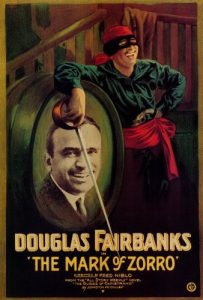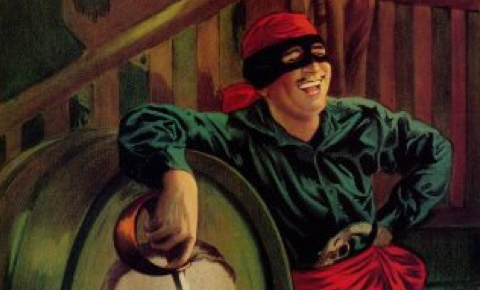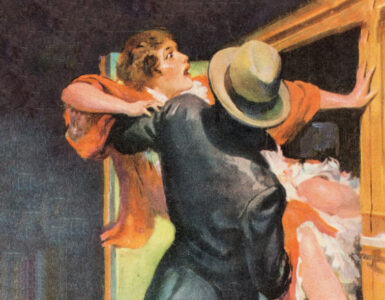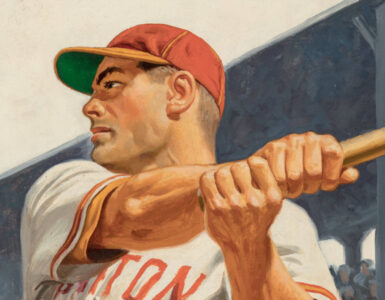 Join PulpFest 2019 on Thursday, August 15, as we welcome pulp and film expert Ed Hulse for “Hollywood Pulp — From Pulp Page to the Silver Screen.” Ed will be debuting a book of the same title at our convention. Having spent decades researching the pulp-film nexus, Ed has shared his findings in a comprehensive encyclopedia that covers many hundreds of movies adapted from rough-paper fiction.
Join PulpFest 2019 on Thursday, August 15, as we welcome pulp and film expert Ed Hulse for “Hollywood Pulp — From Pulp Page to the Silver Screen.” Ed will be debuting a book of the same title at our convention. Having spent decades researching the pulp-film nexus, Ed has shared his findings in a comprehensive encyclopedia that covers many hundreds of movies adapted from rough-paper fiction.
The motion-picture industry was still in its infancy when producers began licensing stories from pulp magazines for adaptation to celluloid. As early as 1912 — when movies were still novelties, screened primarily in store-front nickelodeons — recurring characters from the pulps were featured in short-subject series. That year the Edison Company enjoyed great success with THE CHRONICLES OF CLEEK. These monthly one-reel installments starred Ben Wilson as Thomas A. Hanshew’s “Man of Forty Faces,” a character then appearing regularly in the pulp SHORT STORIES.
Edison’s Cleek series was typical film fare of the day. During the silent movie era, a one-reel short yielded 12 to 15 minutes of screen time — just enough to tell a perfunctory story that might consume 5,000 to 10,000 words in prose. Nickelodeons ran “programs” that grouped four or five such films together. They changed their programs three to five times per week.
With filmmakers under constant pressure to satisfy thrill-hungry viewers, there was a huge market for adaptable yarns. Producers obtained stories from pulps and slicks alike. The two magazines most frequently tapped for material during the pre-1920 period were THE SATURDAY EVENING POST and THE ALL-STORY or ALL-STORY WEEKLY. During this period, many top pulp writers saw their rough-paper fiction immortalized on celluloid. This august group included Max Brand, Edgar Rice Burroughs, George Allan England, Zane Grey, James B. Hendryx, Johnston McCulley, Frank L. Packard, Mary Roberts Rinehart, and Perley Poore Sheehan, among others.
By 1920, the motion-picture industry had mushroomed. Lavish downtown “picture palaces” replaced the seedy nickelodeons, and practically every small town in the country boasted its own movie theater. Production, initially based on the East Coast, gravitated to Hollywood. Wall Street began investing in the most profitable studios. Weekly attendance soared to 40 million people and would continue to grow throughout the Roaring Twenties. Melodramas were second only to comedies as the most popular and profitable screen subjects. This meant that westerns, thrillers, and detective stories were in constant demand. Writers specializing in these genres could usually find a producer to license their pulp yarns if they looked hard (or had aggressive literary agents).
The demand for pulp fiction lessened somewhat as “talking pictures” took over the movie business in the late twenties. As the Great Depression began to affect American consumers, Hollywood was hard hit. In order to compete for the dimes and quarters that bought tickets, the studios increasingly adapted famous stage plays and mainstream novels. Such stories were carried by dialogue, rather than the melodramatic action of the sort found in rough-paper magazines. The Thirties still saw a significant number of pulp-based films, but they were increasingly low-budget “B” pictures and serials emanating from the Poverty Row studios.
Prominent pulp characters brought to the silver screen were Tarzan, Zorro, Buck Rogers, Sam Spade, The Shadow, The Spider, Doc Savage, Conan the Barbarian, and John Carter of Mars, to name just a few. But there were many others not easily recognizable to today’s aficionados. Ed will identify many of these in his presentation, which will be accompanied by a selection of rare stills and posters from the films.
A journalist for nearly forty years, Ed Hulse has written or edited many books about vintage motion pictures and their stars, as well as numerous books about pulp fiction. He was the editor and publisher of BLOOD ‘N’ THUNDER, the award-winning journal devoted to the study of adventure, mystery, and melodrama of the late 19th and early 20th centuries.
PulpFest 2019 will begin on Thursday, August 15, and run through Sunday, August 18. Join PulpFest at the DoubleTree by Hilton Hotel Pittsburgh – Cranberry, just north of Pennsylvania’s “Steel City” of Pittsburgh. We’ll be celebrating “Children of the Pulps and Other Stories” at this year’s convention. Please click our Programming button below our homepage banner to get a preview of all the great presentations at this year’s event.
To join PulpFest 2019, click the Register button below our homepage banner. To book a room at the DoubleTree by Hilton — our host hotel — click the Book a Room button, also found on our homepage.
(THE MARK OF ZORRO — a 1920 silent — is the first of three adaptations of Johnston McCulley’s novel, “The Curse of Capistrano.” It was serialized in five parts in ALL-STORY WEEKLY, beginning with the August 9, 1919 issue. Starring Douglas Fairbanks as the title character and his alter ego, THE MARK OF ZORRO was the first film to be released by United Artists, the company formed by Fairbanks, Mary Pickford, Charlie Chaplin, and D. W. Griffith. The film’s advertising prominently mentioned ALL-STORY WEEKLY, its pulp source. Our presentation, “Hollywood Pulp — From Pulp Page to the Silver Screen,” will include behind-the-scenes information on the making of this historic film.)







